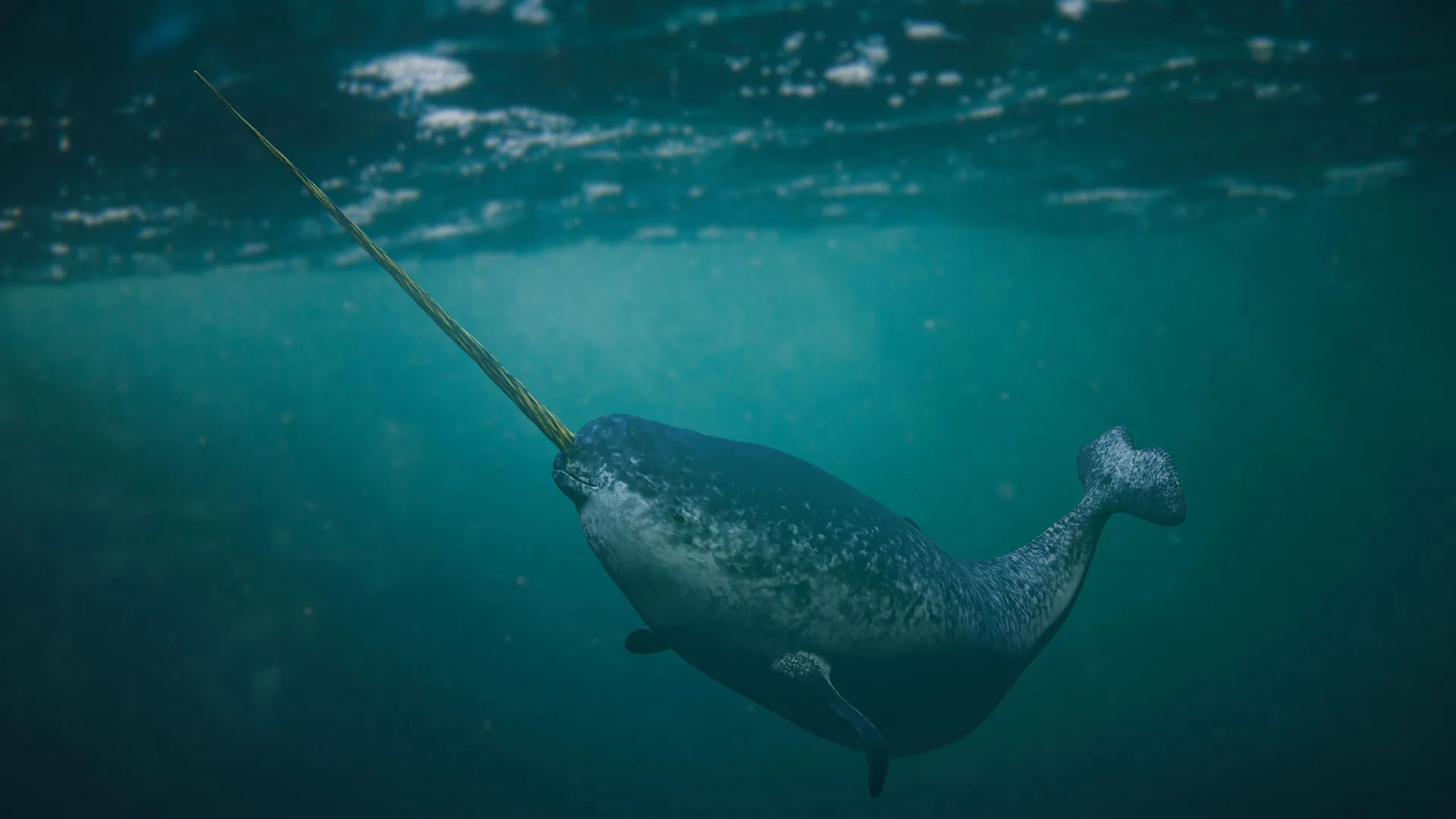Physical Address
304 North Cardinal St.
Dorchester Center, MA 02124

The narwhal, often dubbed the “unicorn of the sea,” is one of the most fascinating and mysterious marine mammals inhabiting the Arctic waters. With its iconic spiral tusk and elusive nature, the narwhal has captivated the imagination of people for centuries. This article delves into the unique adaptations, ecological significance, and the conservation challenges faced by this remarkable creature.
The narwhal’s evolutionary journey is a testament to nature’s ability to adapt to extreme environments. Narwhals belong to the Monodontidae family, which also includes the beluga whale. This family diverged from other cetaceans around 11 million years ago, during the Miocene epoch. The ancestors of the narwhal likely inhabited temperate or subarctic waters, gradually moving northward as the Earth’s climate cooled and ice sheets expanded.
The development of the narwhal’s distinctive tusk is one of the most intriguing aspects of its evolution. While the exact reasons for this adaptation remain speculative, it’s thought that the tusk could have evolved as a multipurpose tool, aiding in both survival and reproduction. The tusk may have provided advantages in sexual selection, with males displaying longer, more impressive tusks gaining better access to mates. Additionally, the tusk’s sensory capabilities might have given narwhals an edge in detecting changes in their environment, such as variations in water temperature and salinity.
The narwhal’s adaptation to the Arctic environment is also evident in its physical characteristics, such as the thick layer of blubber that provides insulation against the freezing waters, and its streamlined body, which allows for efficient swimming under the ice. These evolutionary traits have enabled the narwhal to thrive in one of the most challenging habitats on Earth.
The narwhal is best known for its long, spiral tusk, which can grow up to 10 feet in length. This tusk is actually an elongated tooth, primarily found in males, although some females also possess a shorter version. The purpose of the tusk has been the subject of much speculation and research. Recent studies suggest it may serve multiple functions, including as a sensory organ, a tool for breaking ice, or a means of social interaction and dominance.
Narwhals have evolved to thrive in the harsh Arctic environment. Their blubber provides insulation against the frigid waters, while their streamlined bodies allow them to swim efficiently through icy habitats. They are capable divers, reaching depths of up to 1,500 meters in search of fish, squid, and shrimp, which form the bulk of their diet. Narwhals have the extraordinary ability to slow their heart rates to conserve oxygen during deep dives, enabling them to spend long periods underwater.
Narwhals are social animals, often found in groups called pods, which can consist of a few individuals to several dozen. They communicate using a complex array of clicks, whistles, and knocks, which serve as a means of echolocation, navigation, and social interaction. The social structure of narwhal pods is believed to be matriarchal, with older females often leading the groups.
Narwhals have a relatively long lifespan, living up to 50 years or more in the wild. They reach sexual maturity between 6 and 9 years of age, with females typically giving birth to a single calf every three years. The gestation period lasts around 14 months, and calves are born in the summer, when the Arctic ice is at its minimum, providing a safer environment for the vulnerable newborns.
Narwhals play a crucial role in the Arctic ecosystem. As predators, they help maintain the balance of marine life by controlling the populations of fish and squid. Their migratory patterns also influence the distribution of nutrients in the Arctic waters, contributing to the overall health of the marine environment. The presence of narwhals is an indicator of a healthy ecosystem, as they rely on a stable ice cover and abundant prey for survival.
The narwhal faces numerous threats, primarily due to climate change and human activities. The melting of Arctic ice is one of the most significant challenges, as it disrupts their habitat and migration routes. Additionally, increased shipping traffic, oil and gas exploration, and hunting pose significant risks to their population.
Hunter posing next to a narwhal head (1903)
Conservation efforts are underway to protect the narwhal and its habitat. International agreements, such as the Convention on International Trade in Endangered Species (CITES), regulate the trade of narwhal ivory to prevent overexploitation. Furthermore, organizations like the World Wildlife Fund (WWF) are working to raise awareness and promote sustainable practices to ensure the survival of this iconic species.
(A goblet made from narwhal tusk in Milan, Italy)
The narwhal has held a place in Inuit culture and mythology for centuries. Inuit legends often feature the narwhal, symbolizing strength, endurance, and mystery. The tusk of the narwhal was once believed to be the horn of a mythical unicorn, leading to its high value in European markets during the Middle Ages. Today, the narwhal continues to inspire awe and fascination, embodying the enduring mysteries of the Arctic.
The narwhal has held a place in Inuit culture and mythology for centuries. Inuit legends often feature the narwhal, symbolizing strength, endurance, and mystery. The tusk of the narwhal was once believed to be the horn of a mythical unicorn, leading to its high value in European markets during the Middle Ages. Today, the narwhal continues to inspire awe and fascination, embodying the enduring mysteries of the Arctic.
The narwhal, with its remarkable adaptations and cultural significance, remains one of the most enigmatic creatures of the Arctic. As climate change continues to reshape the Arctic landscape, the survival of the narwhal is increasingly uncertain. However, through concerted conservation efforts and a deeper understanding of this unique species, there is hope that future generations will continue to marvel at the unicorn of the sea. The narwhal’s story is a reminder of the intricate and fragile balance of our planet’s ecosystems, and the responsibility we bear in protecting them.